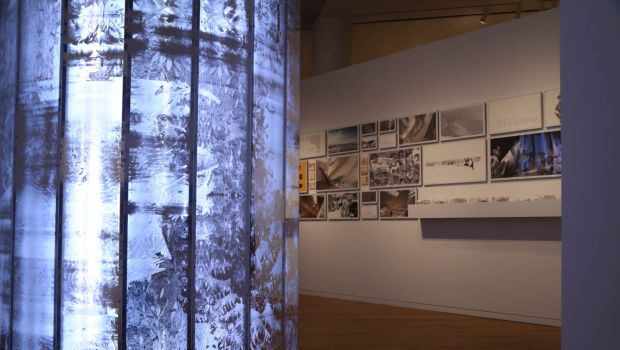
04 Nov DAAP Gallery’s “Eco-Diversity” bridges technology, design, architecture
Mirroring the ideas of the ACADIA conference through computer-generated molds, glowing fields of man-made grass and artful architectural design plans, the school of Design, Architecture, Art and Planning welcomed its new exhibit, “Eco-Diversity: Computation and Identity,” to the Reed Gallery Thursday.
The ACADIA conference, which happened Friday through Sunday, focused on critical thinking in regards to the use of computer technology in the fields of architecture and planning.
Walking up the steps of the DAAP stairwell on the exhibit’s opening night, attendees were greeted with music – or a semblance of it. A collection of notes were strung together by the band viDEO sAVant — led by University of Cincinnati fine arts professor Charles Woodman — in the most unusual way possible, drawing listeners in.
Instead of playing simple elevator-style background music for the gallery opening, DAAP chose to include this band, which creates complex works of music amounting to artistic pieces within themselves. They even had a projector showing animations to go along with every note played.
The choice to include viDEO sAVant was well planned, considering every piece in the new exhibit showcases the unusual quality of technology-inspired design.
“Projective,” by Wendy Fox greets viewers as they enter the gallery and was a resounding hit at the exhibit’s opening. Due to its eye catching potential with harsh contours and bright fluorescent lights, the techni-color structure deserves the honor of being at the forefront.
A duo project between SHO Architects and URL Studio, called “Intr(ə)Scapes,” lurks in the dark corner of the gallery, cementing its place as one of the most complex and interesting pieces in the exhibit.
“Intr(ə)Scapes” is composed of three different platforms with rows of tall, skinny lights attached to them, creating the illusion of glowing patches of grass. When a viewer walks by the piece, motion detectors within the structures pick up their movements and the lights fluctuate in color — green, to purple, to blue.
Catherine Richards’ “Valence” is one of the most visually appealing and artistic pieces made entirely of steel, mirrored plexiglass and neon. The contraption is slightly bigger than life-size, and the intricate designs on the glass are breathtaking.
Matthew Gillis contributed one piece, which was particularly abstract titled “Three Dancers.” It consisted of two large misshapen objects with a black mural beneath them on the floor and on the wall behind them.
The artist seemed to be addressing the idea of fluidity, but it may have flown of over a few viewers’ heads.
“Eco-Diversity: Computation and Identity” brought in a pretty hefty crowd for its opening, free food and drinks helping lure in the typical broke college student. But, it was something more than the food that kept people in the gallery.
The art had people discussing how it was made and the reasons behind why it was made. Intellectual conversations taking place over these pieces were refreshing and exactly what the exhibit was created to evoke from its viewers.
While the concept of this exhibit is difficult to understand upon first setting foot in the gallery, as you walk through and see the collection the theme becomes much clearer. Art and technology can coexist and be utilized together to innovate and reimagine the spaces and designs of the world in which we live.


Sorry, the comment form is closed at this time.